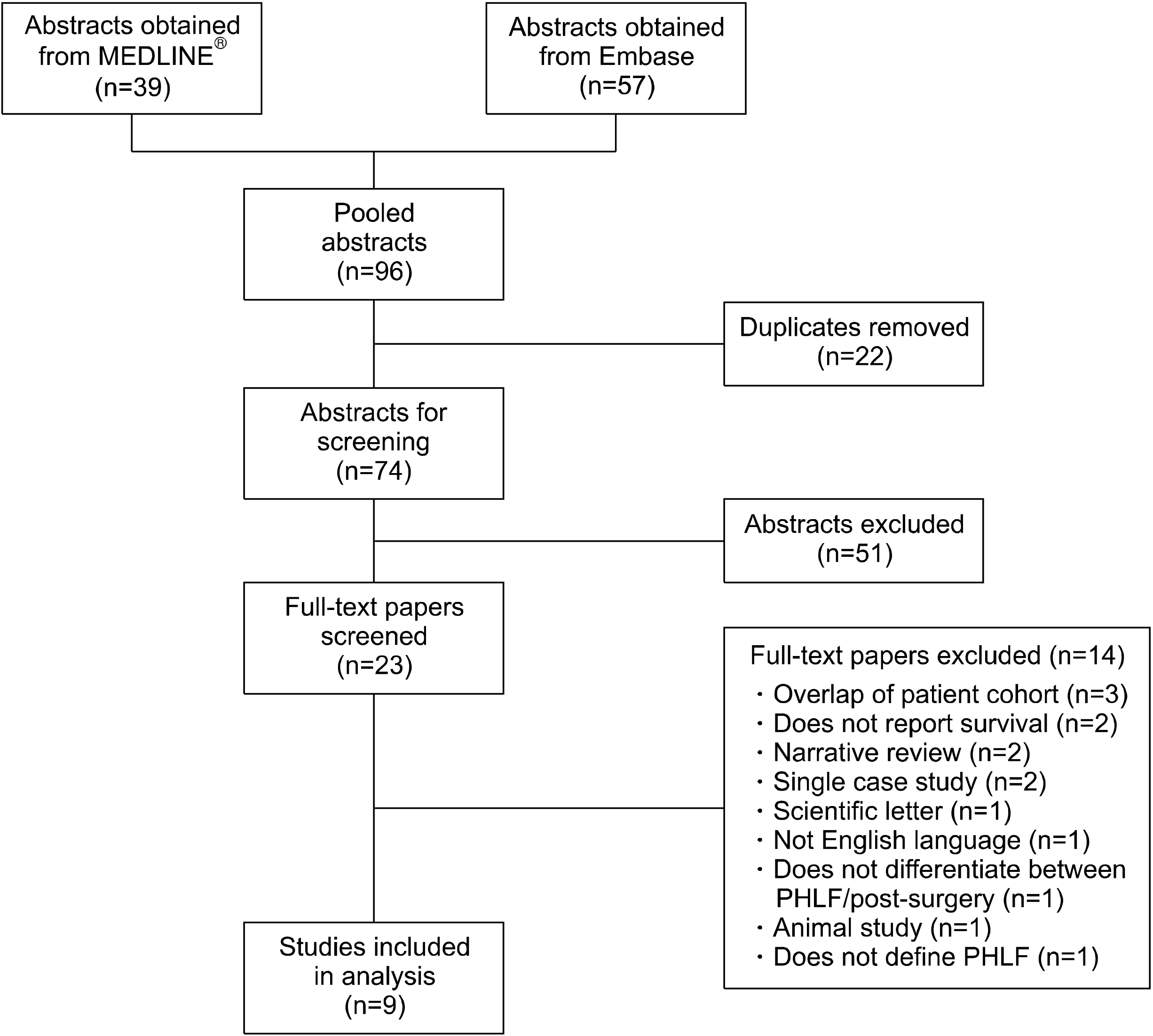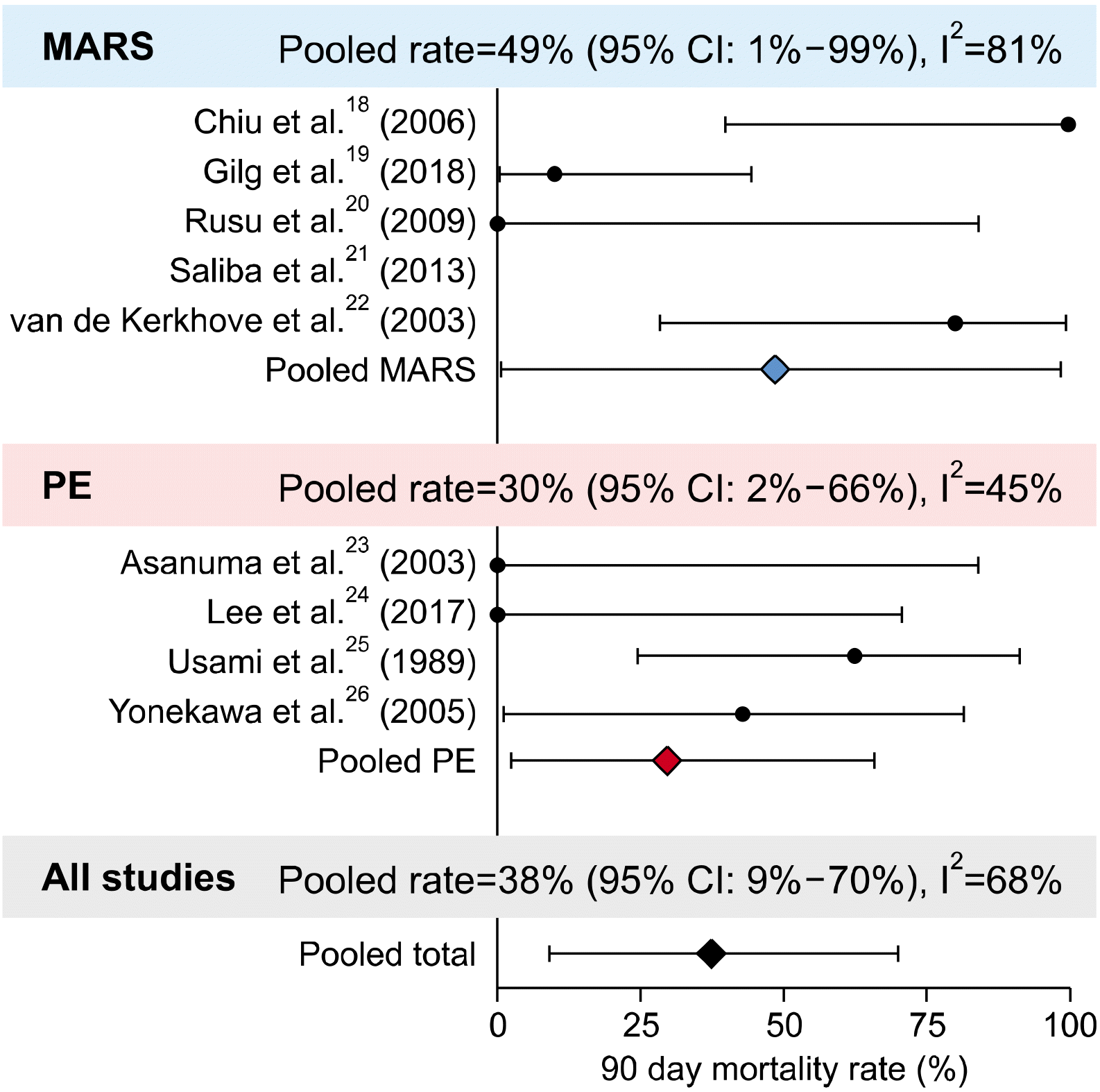1. Poon RT, Fan ST, Lo CM, Liu CL, Lam CM, Yuen WK, et al. 2004; Improving perioperative outcome expands the role of hepatectomy in management of benign and malignant hepatobiliary diseases: analysis of 1222 consecutive patients from a prospective database. Ann Surg. 240:698–708. discussion 708–710. DOI:
10.1097/01.sla.0000141195.66155.0c. PMID:
15383797. PMCID:
PMC1356471.
2. Zheng Y, Yang H, He L, Mao Y, Zhang H, Zhao H, et al. 2017; Reassessment of different criteria for diagnosing post-hepatectomy liver failure: a single-center study of 1683 hepatectomy. Oncotarget. 8:89269–89277. DOI:
10.18632/oncotarget.19360. PMID:
29179518. PMCID:
PMC5687688.

3. Andreatos N, Amini N, Gani F, Margonis GA, Sasaki K, Thompson VM, et al. 2017; Albumin-bilirubin score: predicting short- term outcomes including bile leak and post-hepatectomy liver failure following hepatic resection. J Gastrointest Surg. 21:238–248. DOI:
10.1007/s11605-016-3246-4. PMID:
27619809.
4. Schreckenbach T, Liese J, Bechstein WO, Moench C. 2012; Posthepatectomy liver failure. Dig Surg. 29:79–85. DOI:
10.1159/000335741. PMID:
22441624.

5. Rahbari NN, Garden OJ, Padbury R, Brooke-Smith M, Crawford M, Adam R, et al. 2011; Posthepatectomy liver failure: a definition and grading by the International Study Group of Liver Surgery (ISGLS). Surgery. 149:713–724. DOI:
10.1016/j.surg.2010.10.001. PMID:
21236455.

6. Gilg S, Sparrelid E, Isaksson B, Lundell L, Nowak G, Strömberg C. 2017; Mortality-related risk factors and long-term survival after 4460 liver resections in Sweden-a population-based study. Langenbecks Arch Surg. 402:105–113. DOI:
10.1007/s00423-016-1512-2. PMID:
27695941. PMCID:
PMC5309267.

7. Farges O, Goutte N, Bendersky N, Falissard B. ACHBT-French Hepatectomy Study Group. 2012; Incidence and risks of liver resection: an all-inclusive French nationwide study. Ann Surg. 256:697–704. discussion 704–705. DOI:
10.1097/SLA.0b013e31827241d5. PMID:
23095612.
8. Mullen JT, Ribero D, Reddy SK, Donadon M, Zorzi D, Gautam S, et al. 2007; Hepatic insufficiency and mortality in 1,059 noncirrhotic patients undergoing major hepatectomy. J Am Coll Surg. 204:854–862. discussion 862–864. DOI:
10.1016/j.jamcollsurg.2006.12.032. PMID:
17481498.

9. Kantola T, Ilmakunnas M, Koivusalo AM, Isoniemi H. 2011; Bridging therapies and liver transplantation in acute liver failure, 10 years of MARS experience from Finland. Scand J Surg. 100:8–13. DOI:
10.1177/145749691110000103. PMID:
21482500.

10. Vaid A, Chweich H, Balk EM, Jaber BL. 2012; Molecular adsorbent recirculating system as artificial support therapy for liver failure: a meta-analysis. ASAIO J. 58:51–59. DOI:
10.1097/MAT.0b013e31823fd077. PMID:
22210651.
11. van de Kerkhove MP, de Jong KP, Rijken AM, de Pont AC, van Gulik TM. 2003; MARS treatment in posthepatectomy liver failure. Liver Int. 23 Suppl 3:44–51. DOI:
10.1034/j.1478-3231.23.s.3.2.x. PMID:
12950961.

12. Stange J, Ramlow W, Mitzner S, Schmidt R, Klinkmann H. 1993; Dialysis against a recycled albumin solution enables the removal of albumin-bound toxins. Artif Organs. 17:809–813. DOI:
10.1111/j.1525-1594.1993.tb00635.x. PMID:
8240075.

13. Stange J, Mitzner SR, Risler T, Erley CM, Lauchart W, Goehl H, et al. 1999; Molecular adsorbent recycling system (MARS): clinical results of a new membrane-based blood purification system for bioartificial liver support. Artif Organs. 23:319–330. DOI:
10.1046/j.1525-1594.1999.06122.x. PMID:
10226696.

14. Larsen FS, Schmidt LE, Bernsmeier C, Rasmussen A, Isoniemi H, Patel VC, et al. 2016; High-volume plasma exchange in patients with acute liver failure: an open randomised controlled trial. J Hepatol. 64:69–78. DOI:
10.1016/j.jhep.2015.08.018. PMID:
26325537.

15. European Association for the Study of the Liver. 2017; EASL clinical practical guidelines on the management of acute (fulminant) liver failure. J Hepatol. 66:1047–1081. DOI:
10.1016/j.jhep.2016.12.003. PMID:
28417882.
16. Richardson WS, Wilson MC, Nishikawa J, Hayward RS. 1995; The well-built clinical question: a key to evidence-based decisions. ACP J Club. 123:A12–A13.
17. Miller JJ. 1978; The inverse of the Freeman - Tukey double arcsine transformation. Am Stat. 32:138. DOI:
10.2307/2682942.

18. Chiu A, Chan LM, Fan ST. 2006; Molecular adsorbent recirculating system treatment for patients with liver failure: the Hong Kong experience. Liver Int. 26:695–702. DOI:
10.1111/j.1478-3231.2006.01293.x. PMID:
16842326.

19. Gilg S, Sparrelid E, Saraste L, Nowak G, Wahlin S, Strömberg C, et al. 2018; The molecular adsorbent recirculating system in posthepatectomy liver failure: results from a prospective phase I study. Hepatol Commun. 2:445–454. DOI:
10.1002/hep4.1167. PMID:
29619422. PMCID:
PMC5880195.

20. Rusu EE, Voiculescu M, Zilisteanu DS, Ismail G. 2009; Molecular adsorbents recirculating system in patients with severe liver failure. Experience of a single Romanian centre. J Gastrointestin Liver Dis. 18:311–316.
21. Saliba F, Camus C, Durand F, Mathurin P, Letierce A, Delafosse B, et al. 2013; Albumin dialysis with a noncell artificial liver support device in patients with acute liver failure: a randomized, controlled trial. Ann Intern Med. 159:522–531. DOI:
10.7326/0003-4819-159-8-201310150-00005. PMID:
24126646.
22. van de Kerkhove MP, de Jong KP, Rijken AM, de Pont AC, van Gulik TM. 2003; MARS treatment in posthepatectomy liver failure. Liver Int. 23 Suppl 3:44–51. DOI:
10.1034/j.1478-3231.23.s.3.2.x. PMID:
12950961.

23. Asanuma Y, Sato T, Yasui O, Kurokawa T, Koyama K. 2003; Treatment for postoperative liver failure after major hepatectomy under hepatic total vascular exclusion. J Artif Organs. 6:152–156. DOI:
10.1007/s10047-003-0213-0. PMID:
14621697.

24. Lee HJ, Shin KH, Song D, Lee SM, Chang CL, Chu CW, et al. 2017; Increasing use of therapeutic apheresis as a liver-saving modality. Transfus Apher Sci. 56:385–388. DOI:
10.1016/j.transci.2017.03.001. PMID:
28366590.

25. Usami M, Ohyanagi H, Nishimatsu S, Kasahara H, Shiroiwa H, Ishimoto S, et al. 1989; Therapeutic plasmapheresis for liver failure after hepatectomy. ASAIO Trans. 35:564–567. DOI:
10.1097/00002216-198907000-00127. PMID:
2597535.

26. Yonekawa C, Nakae H, Tajimi K, Asanuma Y. 2005; Effectiveness of combining plasma exchange and continuous hemodiafiltration in patients with postoperative liver failure. Artif Organs. 29:324–328. DOI:
10.1111/j.1525-1594.2005.29054.x. PMID:
15787627.

27. Golriz M, Majlesara A, El Sakka S, Ashrafi M, Arwin J, Fard N, et al. 2016; Small for size and flow (SFSF) syndrome: an alternative description for posthepatectomy liver failure. Clin Res Hepatol Gastroenterol. 40:267–275. DOI:
10.1016/j.clinre.2015.06.024. PMID:
26516057.

28. Eipel C, Abshagen K, Vollmar B. 2010; Regulation of hepatic blood flow: the hepatic arterial buffer response revisited. World J Gastroenterol. 16:6046–6057. DOI:
10.3748/wjg.v16.i48.6046. PMID:
21182219. PMCID:
PMC3012579.

29. Allard MA, Adam R, Bucur PO, Termos S, Cunha AS, Bismuth H, et al. 2013; Posthepatectomy portal vein pressure predicts liver failure and mortality after major liver resection on noncirrhotic liver. Ann Surg. 258:822–829. discussion 829–830. DOI:
10.1097/SLA.0b013e3182a64b38. PMID:
24045452.

31. Simpson KJ, Lukacs NW, Colletti L, Strieter RM, Kunkel SL. 1997; Cytokines and the liver. J Hepatol. 27:1120–1132. DOI:
10.1016/S0168-8278(97)80160-2.

32. Cressman DE, Greenbaum LE, DeAngelis RA, Ciliberto G, Furth EE, Poli V, et al. 1996; Liver failure and defective hepatocyte regeneration in interleukin-6-deficient mice. Science. 274:1379–1383. DOI:
10.1126/science.274.5291.1379. PMID:
8910279.

33. Dello SA, Bloemen JG, van de Poll MC, van Dam RM, Stoot JH, van den Broek MA, et al. 2011; Gut and liver handling of interleukin-6 during liver resection in man. HPB (Oxford). 13:324–331. DOI:
10.1111/j.1477-2574.2010.00289.x. PMID:
21492332. PMCID:
PMC3093644.

34. Blindenbacher A, Wang X, Langer I, Savino R, Terracciano L, Heim MH. 2003; Interleukin 6 is important for survival after partial hepatectomy in mice. Hepatology. 38:674–682. DOI:
10.1053/jhep.2003.50378. PMID:
12939594.

35. Donati G, La Manna G, Cianciolo G, Grandinetti V, Carretta E, Cappuccilli M, et al. 2014; Extracorporeal detoxification for hepatic failure using molecular adsorbent recirculating system: depurative efficiency and clinical results in a long-term follow-up. Artif Organs. 38:125–134. DOI:
10.1111/aor.12106. PMID:
23834711.

36. Dominik A, Stange J, Pfensig C, Borufka L, Weiss-Reining H, Eggert M. 2014; Reduction of elevated cytokine levels in acute/acute- on-chronic liver failure using super-large pore albumin dialysis treatment: an in vitro study. Ther Apher Dial. 18:347–352. DOI:
10.1111/1744-9987.12146. PMID:
24215331.
37. Roth GA, Faybik P, Hetz H, Ankersmit HJ, Hoetzenecker K, Bacher A, et al. 2009; MCP-1 and MIP3-alpha serum levels in acute liver failure and molecular adsorbent recirculating system (MARS) treatment: a pilot study. Scand J Gastroenterol. 44:745–751. DOI:
10.1080/00365520902770086. PMID:
19247846.

38. Stutchfield BM, Simpson K, Wigmore SJ. 2011; Systematic review and meta-analysis of survival following extracorporeal liver support. Br J Surg. 98:623–631. DOI:
10.1002/bjs.7418. PMID:
21462172.

39. Balzan S, Belghiti J, Farges O, Ogata S, Sauvanet A, Delefosse D, et al. 2005; The "50-50 criteria" on postoperative day 5: an accurate predictor of liver failure and death after hepatectomy. Ann Surg. 242:824–828. discussion 828–829. DOI:
10.1097/01.sla.0000189131.90876.9e. PMID:
16327492. PMCID:
PMC1409891.
40. Sparrelid E, Gilg S, van Gulik TM. 2020; Systematic review of MARS treatment in post-hepatectomy liver failure. HPB (Oxford). 22:950–960. DOI:
10.1016/j.hpb.2020.03.013. PMID:
32249030.





 PDF
PDF Citation
Citation Print
Print





 XML Download
XML Download